
The Riverside Historic District is a U.S. historic district located in downtown Evansville, Indiana. It was added to the register in 1978 and roughly bounded by Southlane Drive, Walnut, Third, and Parrett Streets. It consists of 1,010 acres (4.1 km2) and 425 buildings. It is also known as the Riverside Neighborhood.

St. Mark's Episcopal Church, now the Episcopal Parish of St. Mark and St. John, is a historic Episcopal church at 21 Race Street in Jim Thorpe, Carbon County, Pennsylvania. Completed in 1869, it is a prominent example of Gothic Revival architecture designed by that style's leading proponent, Richard Upjohn. It is one of Upjohn's last designs, and was funded by the congregation, which contained eight millionaires whose fortunes were made in the coal fields and railroad industry. It was added to the National Register of Historic Places in 1977, and declared a National Historic Landmark in 1987.

The Warren Historic District, is a national historic district that is located in Warren, Warren County, Pennsylvania.
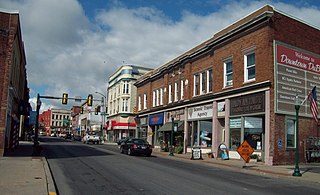
Dubois Historic District is a national historic district located at Dubois, Clearfield County, Pennsylvania. The district includes 54 contributing buildings in the central business district of Dubois. The district consists of mostly commercial buildings built after the fire of 1888 and in a variety of popular architectural styles including Gothic Revival architecture, Italianate, and Romanesque Revival. Notable buildings include the Hatten & Munch Building (1897), Moore & Schwern Building, Methodist Episcopal Church (1889), First Baptist Church (1891), Shaw Building (1895), and DuBois Public Library (1923). Located in the district and separately listed was the Commercial Hotel.
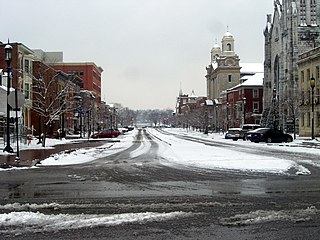
The Harrisburg Historic District is a national historic district which is located in Harrisburg, Dauphin County, Pennsylvania.
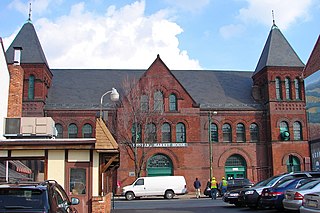
The York Historic District is a national historic district that is located in the central business district and surrounding residential areas of York in York County, Pennsylvania. It is situated north of the Springdale Historic District.

Sinking Springs Farms is a historic farm and national historic district located at Manchester Township in York County, Pennsylvania.

The Towanda Historic District is a national historic district that is located in Towanda, Bradford County, Pennsylvania.

The Henry Albertson Subdivision Historic District, also known as the Henry Albertson Plan and Henry Albertson Property, is an historic subdivision and national historic district which is located in Lansdowne, Delaware County, Pennsylvania.

The River Street Historic District is a national historic district that is located in Wilkes-Barre, Pennsylvania.

The Oil City South Side Historic District, also known as Venango City and Laytonia, is a national historic district that is located in Oil City, Venango County, Pennsylvania, and is situated directly south of the Oil City Downtown Commercial Historic District.

The Waterford Borough Historic District is a national historic district that is located in Waterford, Erie County, Pennsylvania.

The Hulmeville Historic District is a national historic district which is located in Hulmeville, Bucks County, Pennsylvania.
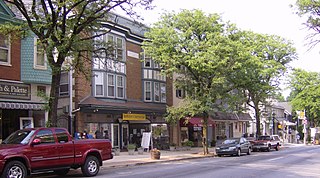
The Kennett Square Historic District is a national historic district that is located in Kennett Square, Chester County, Pennsylvania.
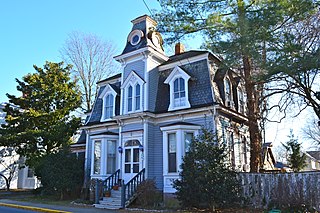
Milton Historic District is a national historic district located at Milton, Sussex County, Delaware. It includes 188 contributing buildings and 1 contributing site in the central business district and surrounding residential areas of Milton. The district includes much of Union, Federal, Broad, Chestnut, and Mill Streets, and encompasses a wide variety of residential, commercial, and institutional buildings from the late-18th century to the early-20th century. Union, Broad and Chestnut Streets include many examples of Gothic Revival and vernacular building styles popular in the 19th century, while Federal Street is noted for larger homes that include many Second Empire, Queen Anne, and Federal style homes, as well as Gothic Revival and vernacular styles. Notable non-residential buildings on Union Street include the Lydia B. Cannon Museum building, the "Irish Eyes" restaurant, and the Milton Theater (1939). On Federal Street, there are the Sussex Trust, Title and Safe Deposit Company building, and the Episcopal Church of St. John Baptist (1877).. Located in the district and separately listed are the Draper-Adkins House, Hazzard House, and Gov. James Ponder House.

Elmwood Historic District–West is a national historic district located at Buffalo, Erie County, New York. The district encompasses 1,971 contributing buildings, 4 contributing structures, and 13 contributing objects in the Elmwood Village neighborhood of Buffalo. It is built around the Buffalo Parks and Parkways system bounded on the north by Delaware Park, Forest Lawn Cemetery, and the former Buffalo State Asylum, on the south by the Allentown Historic District, and on the east by the Elmwood Historic District–East. This predominantly residential district developed between about 1867 and 1941, and includes notable examples of Queen Anne, Shingle Style, Colonial Revival, Tudor Revival, and American Craftsman style architecture. The district contains one of the most intact collections of built resources from turn of the 20th century in the city of Buffalo and western New York State. Located in the district are six previously listed contributing resources including the Richmond Avenue Methodist-Episcopal Church and the Buffalo Tennis and Squash Club. Other notable building include the H.C. Gerber House (1908), the Fred Dullard House (1910), the William H. Scott House (1904), St. John's-Grace Episcopal Church designed by Bertram Grosvenor Goodhue (1925–26), Davidson House (1885), former Jehle Grocery Store and Residence, St. Luke's Episcopal Church, Temple Beth El, Richmond Avenue Church of Christ (now Bryant Parish Condominiums, and Pilgrim-St. Luke's United Church of Christ.

The Charlestown Main Street Historic District encompasses the historic heart of Charlestown, New Hampshire. It is located along Main Street, roughly between Lower Landing Road and Bridge Street, and encapsulates more than two hundred years of the town's history. The district was listed on the National Register of Historic Places in 1987.

Columbia Historic District II is a national historic district located at Columbia, South Carolina. The district encompasses 113 contributing buildings and 1 contributing site in a former residential section of Columbia. They were built between the early-19th century and the 1930s and are now mostly used for commercial purposes. The buildings are in the Greek Revival, Gothic Revival, Classical Revival, and the “Columbia Cottage” styles. Notable buildings include the Robert Mills House, Debruhl-Marshall House, Hampton-Preston House, Episcopal Church of the Good Shepherd, Crawford-Clarkson House, Maxcy Gregg House, Hale-Elmore-Seibels House, St. Paul's Lutheran Church, and Ebenezer Lutheran Church.

Salem Street Historic District is a national historic district located in Thomasville, Davidson County, North Carolina, United States. The district encompasses 33 contributing buildings in a predominantly residential section of Thomasville. They were built between about 1861 and 1957, and include notable examples of Queen Anne and Colonial Revival style architecture. Notable buildings include the Heidelberg Church, St Paul's Episcopal Church, White House, Strickland-Long House, Morris-Harris House, and Leon A. Kress House.

The Boonton Historic District is a 9-acre (3.6 ha) historic district along Main, Church, Birch, Cornelia, and Cedar Streets in the town of Boonton in Morris County, New Jersey. It was added to the National Register of Historic Places on September 29, 1980, for its significance in architecture. The district has 22 contributing buildings, including the Boonton Public Library, which was previously listed individually on the NRHP.































